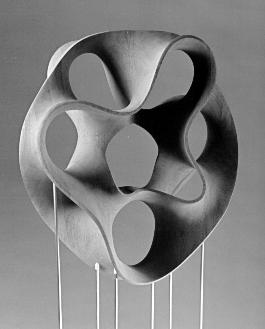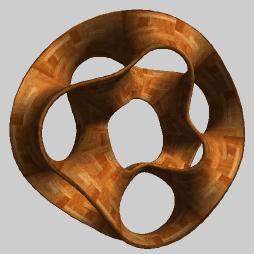Part Description and Specifications for
"Hyperbolic Heptagon"
Origin
This is a toroidal ring of seven ordinary saddles.
It represents the first collaborative effort between
Brent Collins
and
Carlo H. Séquin.
 -
-

The part on the left is Collins' actual sculpture.
The part on the right was generated with Carlo Séquin's
sculpture generator, using the following settings:
- branches = 2
- storeys = 7
- height = 1.15
- flange = 1.50
- thickness = 0.15
- rim_bulge = 1.00
- warp = 360.00
- twist = 90.00
- azimuth = 0.00
- mesh_tiles = 4
- detail = 3
It originally was composed of 1428 biquadratic Bezier patches
which were represented by a total of 172032 triangles.
This shape was then simplified and optimized by Hugues Hoppe
into a shape with only 10,000 triangles.
Usage
This part will serve as a geometrical test model
for various fabrication processes and
for efficient representations of the geometry of such irregular
free-form parts.
This experiment is part of a research program sponsored by NSF
to streamline the process of rapid prototyping of free form parts,
by defining a clean interface between designers and fabricators.
Fabrication Hints
The scale or strength of this model is not critical;
it can be scaled so as to fit optimally a particular process
or some remaining space in a run of a larger piece.
The STL file describes a part
with a diameter (in x) of 81,000 units
and a thickness (in y) of 34,000 units.
The surface walls are 3000 units thick.
Thus when the units are interpreted to mean one to two micro-meters,
we would get parts of a reasonable size.
Orientation is not critical either.
However, for a layered manufacturing process (SLA, SLS, etc), it might be best to
turn the object 90 degrees around the x-axis,
thereby giving the part minimal height.
Part Description File was:
hhh10000.stl.gz
: Mid-resolution version with 10,000 triangular faces (0.52 MB).
<-- Up to Model Index Page
Page Editor:
Carlo H. Séquin
 -
-
